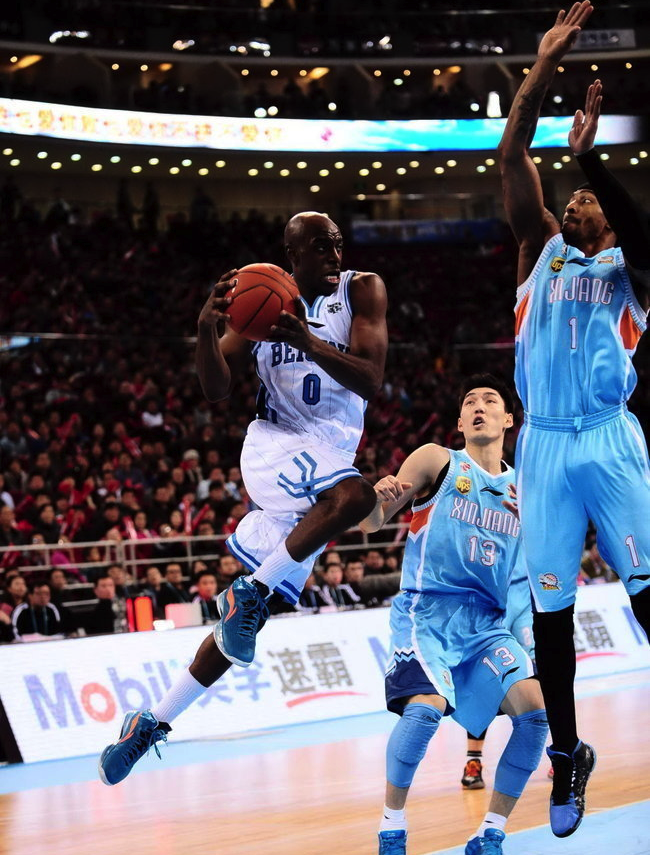The Chinese Basketball Association (CBA) is an amazing league for North American fans to follow. It features old-school, up-tempo basketball with a lot of American players. You’ll undoubtedly see some familiar faces and more than a few career revivals. The CBA is well run and very fan friendly.
This is as good a time as any to start following the CBA – teams are just over the midway mark of the regular season, with the 2014 All-Star Weekend coming this month. My hope is that you’ll be intrigued enough to follow along!
This is the first of a 2-part series. Here in Part 1, I’ll introduce you to the basics of the CBA. In Part 2, I highlight some of best reasons to watch the CBA right now — the crazy lines being put up by the American imports.
League structure
The CBA is composed of 18 teams, with 9 teams in the Northern Division and 9 in Southern Division. There are 34 regular-season games before playoffs.
The playoffs feature seeds 1 through 8, with the first and second rounds played in a best-of-five series, and finals played in a best-of-seven series.
Teams are allowed up to 2 foreign-born players on the roster, or 3 if they finished with a bottom-5 record last season. The only exception to this rule is the Bayi Rockets team, who are affiliated with the Chinese military and do not have any foreign players. Rare, though, is the team that does not rely on American players as their #1 option on offense.
There is a VERY interesting rule, which is: the foreign players on a roster cannot play more than 6 combined quarters in a given game. This allows for some interesting positioning of lineups, and explains why you may not see American stars play the whole game.
Starpower!
You may recognize a fair share of names from CBA rosters:
- Stephon Marbury
- Sebastian Telfair
- Damien Wilkins
- Delonte West
- Bobby Brown
- Eugene “Pooh” Jeter
- Marcus Williams
- Dominique Jones
- Josh Powell
- Quincy Douby
- Ivan Johnson
- Hakim Warrick
- Shavlik Randolph
- Shelden Williams
- Hamed Haddadi
This isn’t even the full list! Every team has 2-3 foreign players who are contributing and making a significant impact.
Scorers’ league
To say that the CBA is a score-first, defense-second league would be an understatement. Owners, fans and coaches value one thing from American players – the ability to put the ball in the basket. In a freewheeling league that aims to please and puts minimal emphasis on defense, you’ll often see 1-on-5 or 2-on-5 play. As a result, many American players have been able to carve out strong identities in China as the go-to guys on their team.
That’s not to say that teams aren’t physical. To put it politely, the line between physical and dirty play is somewhat blurred in the CBA. Smart players, however, quickly adjust and “get theirs” anyway because they can read opposing defenses and get open in a myriad of ways. For players accustomed to college/NBA defenses, the CBA is open season.
Passing through…or here to stay?
The American player base in China is divided into two camps: the residents and the tourists.
In the resident camp you’ll find players like Stephon Marbury, Pooh Jeter and Marcus Williams who are in China for the long haul. They’ve found a second life in the Middle Kingdom and are content to play in a market that celebrates them and rewards them generously. The CBA gives American players strong financial incentives, guaranteed contracts and personal tour guides to entice them to stay.
In the other camp you’ll find, for lack of a better word, the tourists. They’re viewing the CBA experience as a lucrative if temporary endeavor. Think J.R. Smith during the NBA lockout, or current players like Delonte West or Sebastian Telfair who still have a shot back home. These players may have just recently tasted the fringe success of being on an NBA roster, and are hungry to get back. In the meantime, they are getting paid well to try and score 30 or 40 points each game. Tourists truly epitomize the concept of the “hired gun.”
Culture shock and player churn
Regardless of mindset, basketball players face the same general challenges as Americans staying in China – cultural differences, language barrier, food, separation from friends and family. Some players’ tenures last longer than others, and it’s never easy to predict who gets settled in and who “flames out” – booking a one-way ticket back to the United States, never to return.
American players join and leave teams mid-season for various reasons – fallout with team/owner, incompatibility with the Chinese lifestyle, signing with the highest bidder elsewhere, and so on. The residents find themselves in multi-year deals, while others may not last a full season.
Useful sites
For all the rosters, schedules and stats you need:
http://sports.sina.com.cn/cba/
http://www.asia-basket.com/China/basketball.asp
http://sports.cntv.cn/cba/index.shtml
In terms of video content, you’ll find a fair share of them on the following sites:
http://video.sina.com.cn/sports/
Next steps
That’s it for introductions! I hope you’ll keep reading and following the CBA. Have a look at my list of the best things to have happened so far this season, where I highlight some of the best individual American performances.
James Hsu is a Chinese-Canadian writer currently living in Beijing. Follow him on Twitter at @james_hsu.
